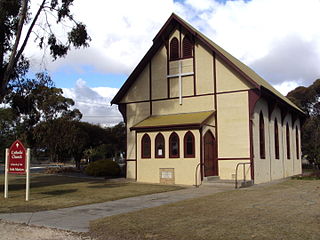
The Ngarrindjeri people are the traditional Aboriginal Australian people of the lower Murray River, eastern Fleurieu Peninsula, and the Coorong of the southern-central area of the state of South Australia. The term ngarrindjeri means "belonging to men", and refers to a "tribal constellation". The Ngarrindjeri actually comprised several distinct if closely related tribal groups, including the Jarildekald, Tanganekald, Meintangk and Ramindjeri, who began to form a unified cultural bloc after remnants of each separate community congregated at Raukkan, South Australia.

Lameroo is a town in the Murray Mallee region of South Australia. It is on the Mallee Highway and Pinnaroo railway line about 40 km west of the Victorian border, or 210 km east of Adelaide. It is primarily a service town for the surrounding rural areas, growing grain and sheep. Lameroo now includes the former settlements of Kulkami, Mulpata, Wirha and Gurrai, which were on the Peebinga railway line, and Wilkawatt, which was between Parrakie and Lameroo on the Pinnaroo railway.
The Ramindjeri or Raminjeri people were an Aboriginal Australian people forming part of the Kukabrak grouping now otherwise known as the Ngarrindjeri people. They were the most westerly Ngarrindjeri, living in the area around Encounter Bay and Goolwa in southern South Australia, including Victor Harbor and Port Elliot. In modern native title actions a much more extensive territory has been claimed.
The Ngadjuri people are a group of Aboriginal Australian people whose traditional lands lie in the mid north of South Australia with a territory extending from Gawler in the south to Orroroo in the Flinders Ranges in the north.
The Murraylands is a geographical region in South Australia; generally, the lower part of the Murray River basin, in South-Eastern South Australia. The area stretches from Blanchetown; roughly 130 kilometres north-east of Adelaide, right down to Wellington, which is situated at the beginning of Lake Alexandrina.

Jarijari were an indigenous Australian people whose traditional territory was located in the Mallee region of Victoria.
The Erawirung people, also known as Yirau, Juju and other names, were an Aboriginal Australian people whose traditional territory was located in what is today the Riverland of South Australia. They consisted of sub-groups or clans, including Jeraruk, Rankbirit and Wilu, and have been referred to as Meru people, which was a larger grouping which could also include the Ngawait and Ngaiawang peoples.
The Maraura or Marrawarra people are an Aboriginal group whose traditional lands are located in Far West New South Wales and South Australia, Australia.
The Bininj are an Aboriginal Australian people of Western Arnhem land in the Northern Territory. The sub-groups of Bininj are sometimes referred to by the various language dialects spoken in the region, that is, the group of dialects known as Bininj Gun-Wok; so the people may be named Gunwinggu, the Kuninjku, Kundjeyhmi (Gundjeihmi), Manyallaluk Mayali, Kundedjnjenghmi and Kune groups. In addition, there are clan groups such as the Mirrar who are prominent in matters relating to looking after the traditional lands.

.
The Barindji, also written Parrintyi, are an indigenous Australian people of the state of New South Wales. They are to be distinguished from the Paaruntyi, who spoke a similar language but whom they called the spitting people.
The Jarildekald (Yarilde) are an indigenous Australian people of South Australia originating on the eastern side of Lake Alexandrina and the Murray River.
The Ngaiawang (Ngayawang) were an Aboriginal Australian people of the western Riverland area of South Australia, with a language considered part of the Lower Murray group. They are now considered extinct. They have sometimes been referred to as part of the Meru people, a larger grouping which could also include the Ngawait and Erawirung peoples. They were called Birta by the Kaurna and Ngadjuri peoples, variations of Murundi by the Jarildekald people, and were also known various other terms and spellings.
The Ngintait, or Ngindadj, were an indigenous Australian people of the northwest corner of the state of Victoria, and partly in South Australia. 9 people, all of one family, claim descent from the tribe, which was dispersed in the 19th century.
The Latjilatji, sometimes spelt Latji Latji or Latje Latje are an Indigenous Australian people of the state of Victoria, Australia.
The Girramay were an Australian Aboriginal tribe of northern Queensland.
The Bodaruwitj, also rendered Bedaruwidj or Potaruwutj, and referred to in some early sources as the Tatiara, are an Aboriginal Australian people of the state of South Australia. Some authorities believe they are extinct. David Horton believed they were the group his sources referred to as the Bindjali people. Austlang refers to Bindjali / Bodaruwitj as alternative names for the same language.
The Thangkaali (Danggali) are an indigenous Australian people of the state of South Australia.
The Ngawait, also spelt Ngawadj and other variations, and also known as Eritark and other names, were an Aboriginal Australian people of the mid-Riverland region, spanning the Murray River in South Australia. They have sometimes been referred to as part of the Meru people, a larger grouping which could also include the Ngaiawang and Erawirung peoples. There were at least two clans or sub-groups of the Ngawait people, the Barmerara Meru and Muljulpero maru.
The Dhirari were an indigenous Australian people of the state of South Australia. They are not to be confused with the Diyari people, though the Dirari/Dhirari language was a dialect of the Diyari language.